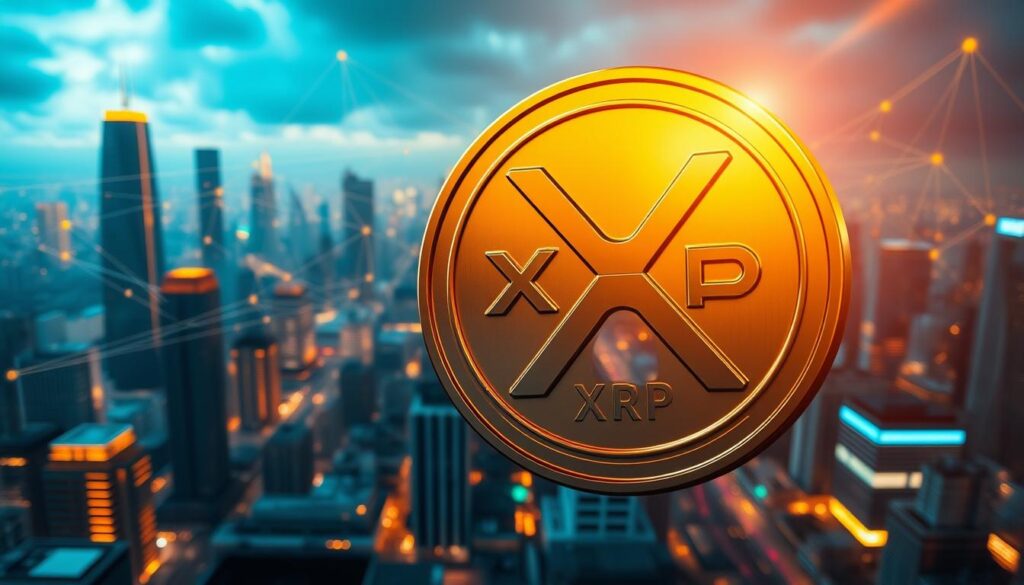
Have you ever wondered how a digital asset could revolutionize global financial transactions? XRP cryptocurrency stands at the forefront of this financial transformation, challenging traditional banking systems with its innovative approach to money transfer.
XRP is a digital currency designed to enable rapid, secure, and cost-effective global transactions. Created by Ripple Labs, this unique cryptocurrency differs from Bitcoin and Ethereum by focusing on solving real-world payment challenges. Its primary goal is to provide seamless cross-border payment solutions that are faster and cheaper than traditional banking methods.
Unlike many cryptocurrencies that aim to replace traditional currencies, XRP works alongside existing financial systems. Its technology allows banks, payment providers, and digital exchanges to process international transactions in seconds, with minimal transaction fees. This approach makes XRP a fascinating player in the evolving digital finance landscape.
As you explore the world of XRP cryptocurrency, you’ll discover a digital asset that’s not just about speculation, but about creating practical, efficient financial solutions for a global economy. Whether you’re a financial enthusiast or simply curious about emerging technologies, understanding XRP can provide insights into the future of digital transactions.
Understanding XRP: The Digital Asset Powering Global Transactions

XRP stands out as a revolutionary digital asset designed to transform how global financial transactions occur. Created by Ripple Labs, this unique cryptocurrency differs from traditional digital currencies by focusing on institutional payment solutions. Your understanding of XRP can unlock insights into a more efficient financial ecosystem.
The ripple XRP digital asset provides lightning-fast transaction processing compared to traditional banking systems. Financial institutions can transfer funds across borders in seconds, reducing transaction costs and eliminating complex intermediary steps. This approach makes XRP an attractive solution for banks and payment providers seeking streamlined global money transfers.
Unlike many cryptocurrencies that prioritize individual transactions, XRP targets enterprise-level financial networks. Its technology enables near-instantaneous cross-border payments with minimal fees. The digital asset’s infrastructure supports rapid verification and settlement, making it a powerful tool for international financial interactions.
Ripple XRP operates on a unique consensus protocol that differs from Bitcoin’s energy-intensive mining process. This approach makes the digital asset more environmentally friendly and scalable. Financial professionals appreciate XRP’s ability to handle thousands of transactions per second with remarkable efficiency.
Your exploration of XRP reveals a digital asset designed to solve real-world financial challenges. By bridging traditional banking systems with cutting-edge blockchain technology, XRP represents a significant innovation in global payment infrastructure.
What is XRP and How Does It Work?

XRP represents a powerful digital asset designed to revolutionize financial transactions. At its core, the XRP blockchain provides a lightning-fast network for moving money globally. Unlike traditional cryptocurrencies, XRP uses a unique consensus mechanism that enables rapid transaction processing.
When you explore what is XRP, you’ll discover a digital payment protocol built for speed and efficiency. The XRP blockchain operates differently from Bitcoin or Ethereum, focusing on near-instantaneous cross-border transactions. Each transaction on the network takes just 3-5 seconds, compared to minutes or hours with other cryptocurrencies.
The XRP token serves as a bridge currency, allowing seamless transfers between different monetary systems. Financial institutions can use XRP to facilitate quick international payments with minimal transaction fees. This innovative approach eliminates the need for multiple currency conversions, reducing complexity and cost in global money transfers.
Ripple, the company behind XRP, designed the network to solve real-world financial challenges. The XRP blockchain can handle 1,500 transactions per second, making it one of the most scalable digital payment systems available. This remarkable capability positions XRP as a potential game-changer in digital finance and global monetary transactions.
The XRP Ledger: Foundation of Fast Transactions

The XRP Ledger represents a groundbreaking approach to digital transactions, offering unprecedented speed and efficiency in the world of cryptocurrency. Unlike traditional blockchain networks, this innovative platform enables xrp real-time settlement with remarkable precision and reliability.
At its core, the XRP blockchain provides a decentralized network that processes transactions in seconds, not minutes or hours. This unique capability sets it apart from other cryptocurrency platforms. You can experience near-instantaneous global transfers that would typically take days through traditional banking systems.
The technical architecture of the XRP Ledger allows for high-speed consensus mechanisms. Each transaction is verified by a distributed network of validators, ensuring security and transparency. This approach eliminates the need for energy-intensive mining processes that plague many cryptocurrency platforms.
When you use XRP for cross-border payments, you benefit from extremely low transaction costs and rapid settlement times. The ledger can handle up to 1,500 transactions per second, making it one of the most efficient digital payment systems available today.
Understanding the XRP Ledger means recognizing its potential to revolutionize financial transactions. Its robust infrastructure supports complex financial operations while maintaining exceptional speed and security for users worldwide.
Benefits of Using XRP for Cross-Border Payments

XRP has emerged as a game-changing solution for international financial transactions. When you consider xrp cross-border payments, the advantages become crystal clear. Traditional international money transfers can take days and involve hefty fees. XRP transforms this landscape by enabling near-instantaneous global transactions.
XRP real-time settlement represents a breakthrough in digital finance. Your international payments can now be processed in mere seconds, compared to traditional banking systems that might take 3-5 business days. The digital asset provides remarkable speed and efficiency for businesses and individuals sending money across borders.
The cost savings are significant. XRP dramatically reduces transaction fees compared to conventional wire transfers or international payment networks. Banks and financial institutions can save up to 70% on cross-border payment expenses by implementing XRP technology. This makes international transactions more accessible and affordable for everyone.
Liquidity becomes seamless with XRP. The digital asset allows for on-demand currency exchange without needing pre-funded accounts in destination countries. Your money moves quickly and efficiently, eliminating complex intermediary steps that typically slow down international transfers.
Global financial institutions are taking notice. Major banks and payment providers are exploring XRP as a strategic solution for streamlining international money movements. The technology promises to revolutionize how we think about global financial transactions.
XRP’s Role in the Global Remittance Network

The xrp remittance network is revolutionizing how people send money across borders. Ripple XRP has emerged as a powerful solution for international money transfers, offering unprecedented speed and efficiency. Traditional remittance systems often involve multiple intermediaries, high fees, and slow processing times.
Ripple XRP tackles these challenges by providing a streamlined digital payment protocol. Financial institutions worldwide are recognizing the potential of this technology to transform cross-border transactions. The xrp remittance network enables near-instantaneous transfers at a fraction of the cost of traditional banking methods.
You’ll find that Ripple XRP’s blockchain technology allows for direct asset exchanges between different currencies. This means you can send money internationally without multiple conversion steps. Banks and financial services are increasingly partnering with Ripple to leverage its advanced payment infrastructure.
The technology’s real-world impact is significant. Remittance networks powered by XRP can reduce transaction costs by up to 70%, making international money transfers more accessible for millions of people globally. As regulatory frameworks evolve, the potential for XRP to disrupt traditional financial systems continues to grow.
By choosing XRP for international transfers, you’re accessing a cutting-edge financial technology that promises faster, cheaper, and more transparent global transactions.
Understanding XRP Market Performance and Price Factors
XRP price analysis reveals a complex and dynamic cryptocurrency market landscape. Your understanding of XRP’s market performance starts with tracking its market capitalization, which reflects the digital asset’s total value and investor sentiment. Cryptocurrency markets experience significant volatility, making XRP an intriguing investment opportunity for many traders.
Several key factors influence XRP’s market value. Regulatory developments play a crucial role in shaping investor confidence. The ongoing legal battles and regulatory clarity surrounding Ripple have directly impacted XRP’s price movements. Global financial market trends, technological advancements, and adoption rates within the Ripple ecosystem also contribute to price fluctuations.
When conducting XRP market capitalization research, you’ll notice the cryptocurrency’s unique position in the digital finance landscape. Its utility in cross-border transactions sets it apart from other digital assets. Institutional interest, partnerships, and technological innovations continue to drive XRP’s market performance, making it an exciting asset to watch for potential investors.
Traders and investors closely monitor XRP’s price analysis to make informed decisions. The cryptocurrency’s ability to facilitate fast, low-cost international transactions provides underlying value beyond pure speculation. Understanding these market dynamics can help you navigate the complex world of digital assets more effectively.
How to Buy, Store, and Trade XRP
Getting started with XRP cryptocurrency requires understanding the basics of purchasing, storing, and trading. Your first step is selecting a reputable cryptocurrency exchange that supports XRP trading. Popular platforms like Coinbase, Binance, and Kraken offer straightforward ways to buy XRP using US dollars or other digital currencies.
When purchasing XRP, you’ll need to create an account and complete identity verification processes. Most exchanges require government-issued ID and proof of address. After verification, you can link a payment method such as bank account or credit card to fund your XRP purchase. The minimum investment varies by platform, but many allow you to start with small amounts.
Storing XRP safely is crucial for protecting your digital assets. Hardware wallets like Ledger and Trezor provide the most secure storage option, keeping your XRP offline and protected from potential cyber threats. Software wallets offer convenient mobile or desktop access, while exchange wallets remain the least secure method for long-term XRP storage.
Trading XRP involves understanding market dynamics and price fluctuations. Beginners should start with small trades and develop a strategy based on market research. Watch for XRP trading pairs with Bitcoin and Ethereum, which offer multiple trading opportunities. Always monitor market trends and set realistic investment goals when participating in the XRP cryptocurrency ecosystem.
XRP’s Environmental Impact and Sustainability
As the world becomes more conscious of environmental sustainability, the xrp digital asset stands out for its eco-friendly approach to blockchain technology. Unlike traditional cryptocurrencies that consume massive amounts of energy, XRP offers a remarkably green alternative for digital transactions.
The XRP blockchain operates through a unique consensus mechanism that drastically reduces energy consumption. Traditional proof-of-work cryptocurrencies require extensive computational power, while XRP’s system allows for rapid, efficient transactions with minimal environmental impact. This makes the xrp digital asset an attractive option for environmentally conscious investors and businesses.
Ripple, the company behind XRP, has committed to sustainable practices that go beyond just energy efficiency. Their technology enables faster cross-border transactions with a carbon footprint significantly lower than traditional banking systems. By streamlining financial processes, XRP helps reduce unnecessary energy waste associated with complex international money transfers.
You’ll appreciate that XRP’s approach to sustainability isn’t just about reducing energy use. The blockchain’s design prioritizes efficient resource allocation, ensuring that each transaction requires minimal computational resources. This commitment to environmental responsibility positions XRP as a forward-thinking digital asset in the rapidly evolving world of cryptocurrency.
For investors and technology enthusiasts concerned about ecological impact, XRP represents a promising path toward more sustainable digital finance. Its innovative blockchain technology demonstrates that high-performance financial systems can coexist with environmental consciousness.
The Future Outlook of XRP in Digital Finance
XRP is poised to revolutionize digital finance through its innovative approach to cross-border payments. The cryptocurrency’s potential extends far beyond traditional transaction methods, promising transformative solutions for global financial networks.
Your understanding of XRP’s future begins with its remarkable xrp cross-border payments technology. Financial institutions are increasingly recognizing the cryptocurrency’s ability to streamline international transactions, reducing costs and processing times dramatically.
The xrp remittance network continues to evolve, targeting emerging markets where traditional banking infrastructure remains limited. Developing economies could benefit significantly from XRP’s quick and affordable transaction capabilities, potentially democratizing financial access worldwide.
Ripple’s strategic partnerships with global financial institutions suggest a promising trajectory for XRP. The cryptocurrency might play a crucial role in bridging traditional banking systems with cutting-edge digital finance technologies.
Regulatory developments will critically shape XRP’s future. Ongoing discussions about cryptocurrency regulations could either accelerate or challenge its widespread adoption. Investors and financial professionals are watching these developments closely.
Technological innovations like smart contracts and decentralized finance applications could further expand XRP’s utility. The cryptocurrency’s adaptable blockchain technology positions it as a potential game-changer in digital financial ecosystems.
Conclusion: XRP’s Place in the Evolving Cryptocurrency Landscape
As you explore the world of digital finance, XRP cryptocurrency emerges as a transformative force in global transactions. Ripple XRP has demonstrated remarkable potential to revolutionize how money moves across borders, offering unprecedented speed and efficiency in financial exchanges. The technology behind XRP represents a significant leap forward in addressing traditional banking limitations.
Your understanding of XRP now extends beyond simple cryptocurrency trading. The digital asset stands poised to challenge existing financial infrastructure, providing faster, more cost-effective solutions for international money transfers. Ripple XRP’s innovative approach to blockchain technology creates opportunities for streamlined global financial interactions that were previously impossible.
The future of XRP cryptocurrency looks promising, with continued development and increasing adoption by financial institutions. As blockchain technology evolves, you can expect XRP to play a pivotal role in reshaping how we conceptualize and execute financial transactions. The potential for disruption in traditional banking systems remains significant, offering exciting prospects for those willing to embrace digital financial innovations.
Ultimately, XRP represents more than just a digital asset—it’s a glimpse into the future of global financial connectivity. Whether you’re an investor, technology enthusiast, or financial professional, the journey of Ripple XRP offers a compelling narrative of innovation, potential, and transformative technological advancement in the digital economy.






